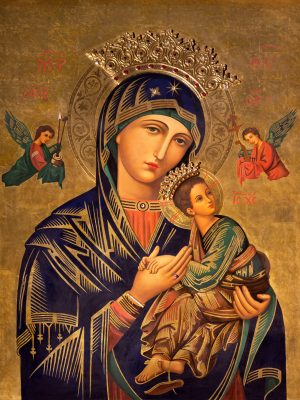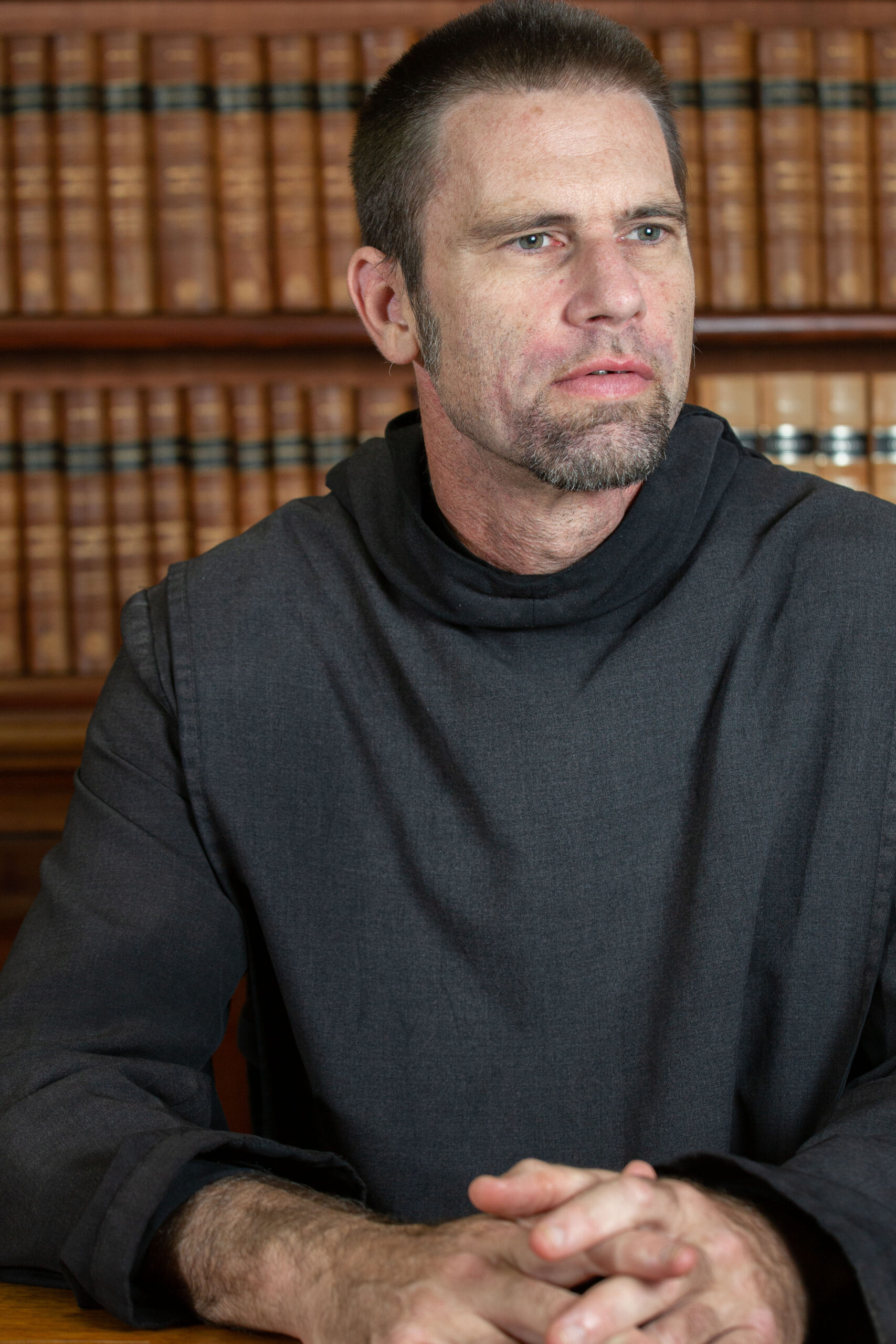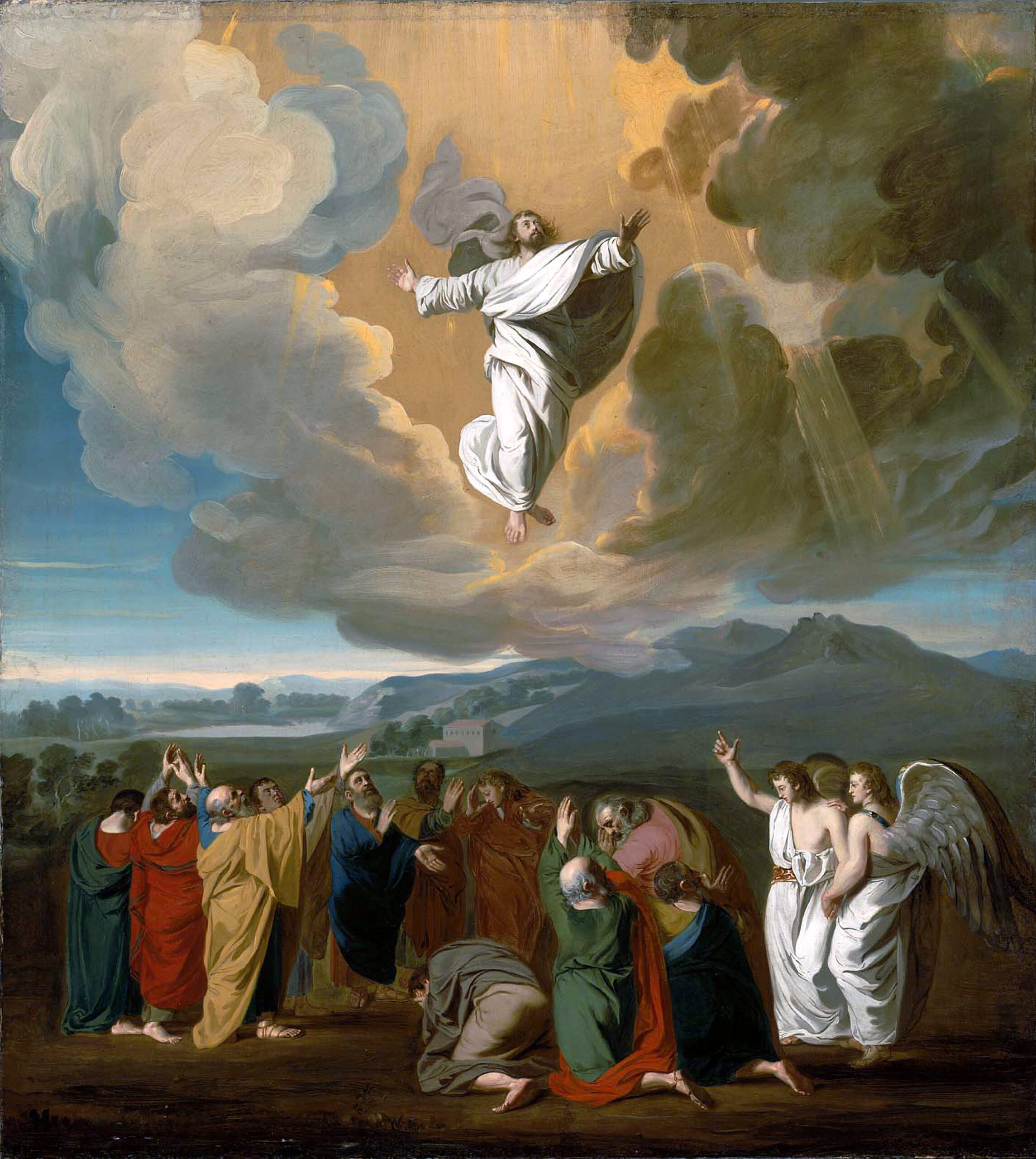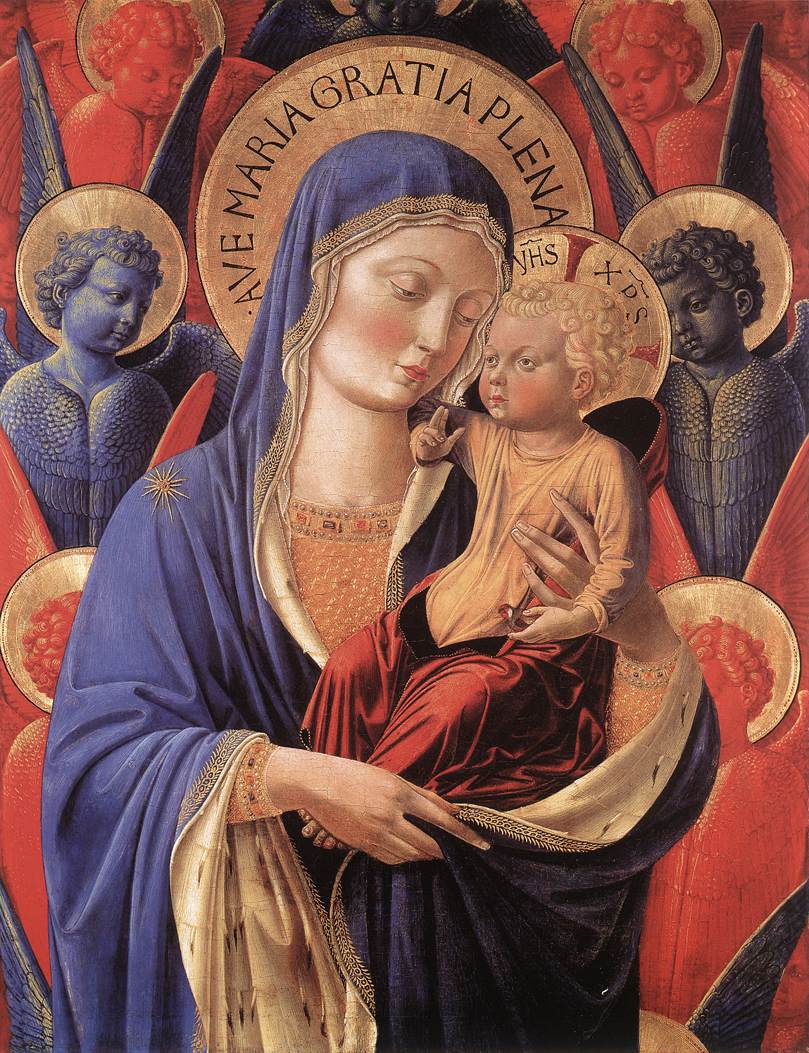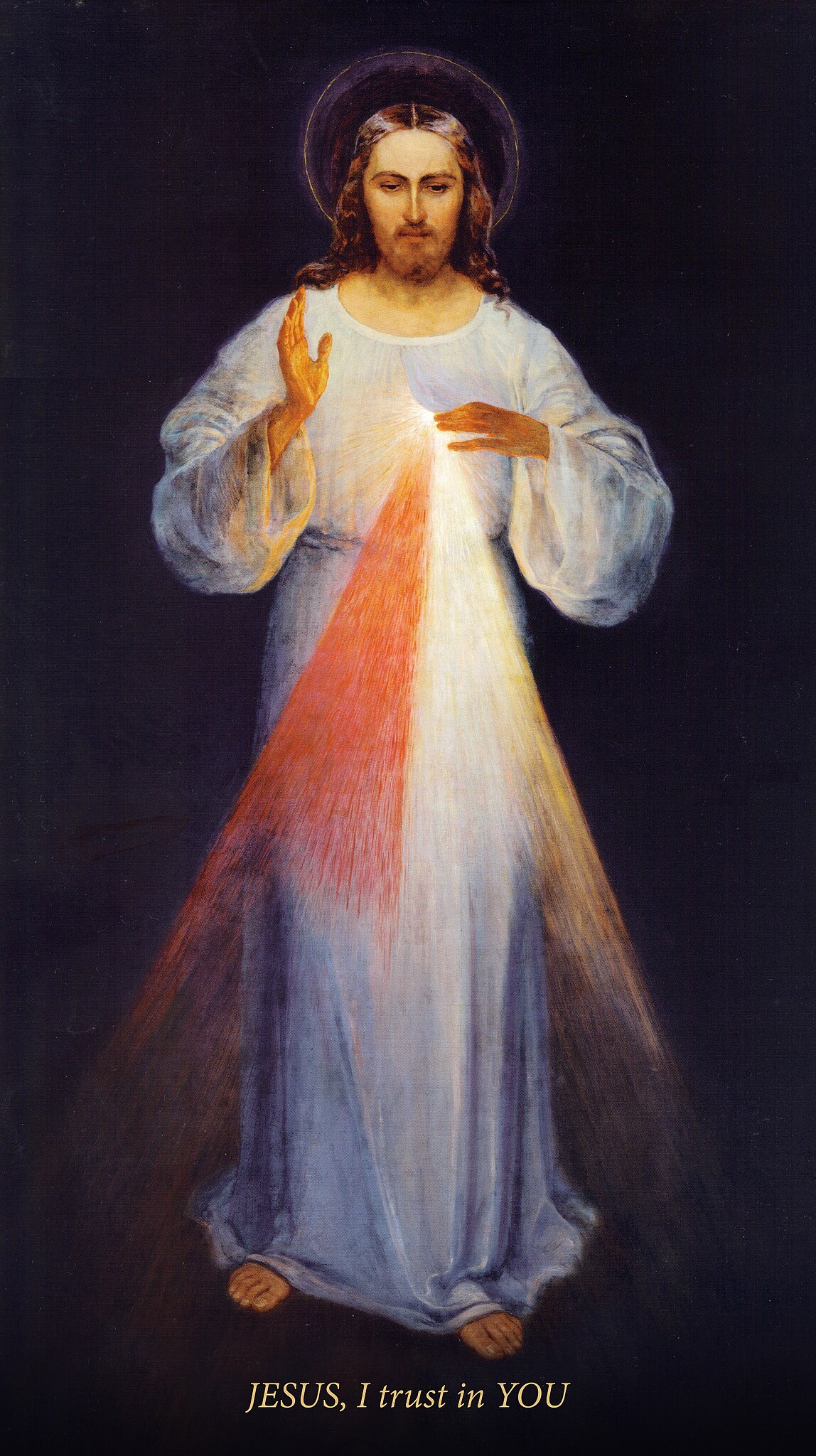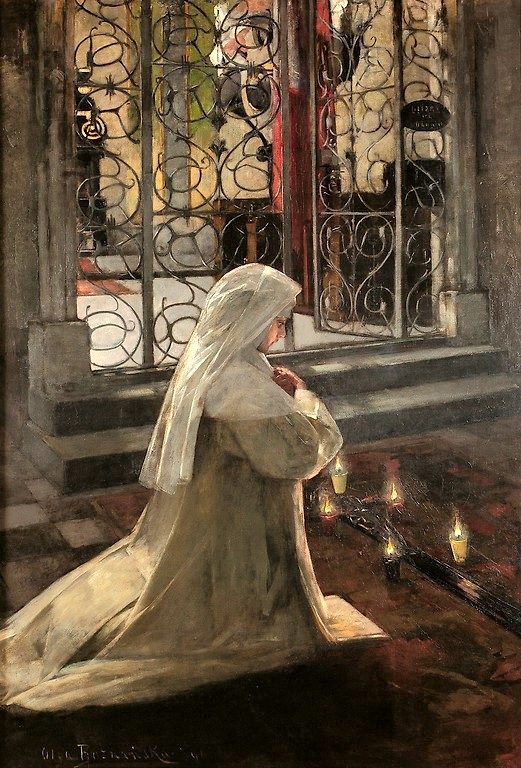The Salve Regina, after the Hail Mary, is undoubtedly the best-known and best-loved Marian prayer within the Catholic tradition. It is recited at the conclusion of each mystery of the Rosary; and, for those in monastic and consecrated life, it is traditionally sung as a final antiphon at night after compline, throughout most seasons of the year. The Salve Regina is a fervent outpouring of love and devotion to the Queen of Heaven, addressing her in tones of the most passionate filial supplication:
Hail, holy Queen, Mother of mercy,
Hail, our life, our sweetness and our hope.
To thee do we cry, poor banished children of Eve:
To thee do we send up our sighs, Mourning and weeping in this vale of tears.
Turn then, most gracious Advocate, thine eyes of mercy toward us,
And after this our exile, show unto us the blessed fruit of thy womb, Jesus,
O clement, O loving, O sweet Virgin Mary!
Amen.
From an examination of the appearance of the antiphon in manuscript sources, as well as from its style, language and imagery, it is clear that it dates from about the 11th century. Nevertheless, the question of the authorship of this beautiful antiphon remains uncertain. In this regard, two possibilities are often advanced—namely, Saint Bernard of Clairvaux (1090–1153) and Blessed Herman of Reichenau (also known as Hermannus Contractus) (1013–1034). Both of these authors were monks, and both wrote other works which express a similar heart-felt and touching devotion to the Mother of God.
Many versions of the life of Saint Bernard of Clairvaux have been passed down to us, the best-known of which are those of William of Saint-Thierry and Gaufrid of Clairvaux. But one of the most vivid and fascinating literary accounts of the life of the great monastic reformer is that of a certain John the Hermit, which, unfortunately, is relatively unknown today (and has not yet been translated into English). This biography provides us with a truly spell-binding anecdote of how the text of the Salve Regina was communicated to Bernard in a mystical vision:
“One night, Bernard was sleeping in the dormitory amongst the other monks, when he heard a glorious sound of voices coming from the chapel. So, without waking anyone else, he quietly went to the chapel, and—behold!—there were multitudes of angels within, bathed in the radiant refulgence of celestial light. They were singing the praises of almighty God and the most holy Mother of God, in resonant waves of indescribably mellifluous harmonies. And he saw the blessed Mary herself standing in their midst! She held a golden thurifer in one hand and an incense boat in the other. One of the angels led Bernard to the right side of the altar, next to the glorious Virgin. And there he heard sung in an angelic voice the Salve Regina. Bernard remembered carefully all that he heard, and, the next day wrote it down completely and precisely, and sent a copy to Pope Eugenius III. The pontiff then mandated that this antiphon should be solemnly sung in all churches throughout the world, in honor of the great Mother of God.”
This remarkable narrative indicates that Bernard served as a scribe or amanuensis in the production of the Salve Regina, rather than its actual author. One of the principal objections to the proposal that the text originated from Bernard is the fact that he also composed a commentary on the antiphon, which seems to treat the text as if it were not his own. But if, as John the Hermit’s account suggests, he simply recorded a text he had received in a vision rather than composed a new one of his own invention, then his treatment of the text in his commentary would seem to make perfect sense.
The second possibility (which is more generally favored by scholars today) is that the text was written by Blessed Herman of Reichenau. Consistent with this is the consideration that Herman is known to have written various other Marian antiphons, which exhibit a congruency of literary style and theological tone to the Salve Regina. His cognomen ‘Contractus’ (sometimes rendered as ‘the Lame’) refers to the fact that he suffered a physical handicap, which caused a contraction of his body and severely impaired his mobility. Despite this, he was renowned as one of the greatest scholars of his age, mastering not only Latin, but also Greek and (what was very rare at the time) Arabic. Though venerated as a saint since shortly after his death, his beatification was formally recognized only in 1863.
According to the brief account of the life of Herman found in the encyclopedic De Viris Illustribus Ordinis Sancti Benedicti (‘Illustrious Persons of the Order of Saint Benedict’) by the great scholar and polymath Johannes Trithemius (1452–1516), it was the Blessed Virgin herself who granted to Herman his marvelous erudition and linguistic skills. Trithemius’s version of the life of Herman (which has never been previously published in English) is given in its entirety below.
“Herman, a monk known by the nickname ‘Contractus,’ was a German by nationality and (so it is said) the son of the count of Veringenstad. He was a learned man, extremely expert in all secular literature, and most celebrated as a philosopher, astronomer, musician and poet. In intellect, he was extremely subtle, and in speech, very eloquent. He was also a master of the Greek and Arabic tongues.
Herman composed a great many scientific treatises, including: On Music, On the Six Ages, On the Astrolabe, On the Eclipses of the Sun and Moon, and On Computation. He wrote the histories and legends of many saints, and composed hymns, antiphons and delightful chants. Several of these we may still hear sung in our churches. It was this Herman who composed the Salve Regina, that devout antiphon in praise of the blessed Mary, the Mother of God, which the entire church now sings in her honor. He also translated many works for Greek and Arabic into Latin.
This Herman was (as we have said) the heir to the count of Veringenstad in Swabia. In his youth, he became lame, and it was from this affliction that he was given his nickname [‘Contractus.’] Once he had become a monk, with great devotion and fervent prayers he implored the Blessed Virgin that she should deign to heal him, through her merits. He is said to have received from her this response, ‘My dearest son, I have heard your diligent prayers, and have procured for you from God the option of two choices. Choose which one you prefer! Either you may remain lame, but receive perfect knowledge of all Scriptures and all scholarly disciplines; or you may receive physical healing, but you shall remain unlearned. If you choose this second option, you will also become a bishop. Now which of these two options would you prefer?’
Herman carefully considered the options which the Queen of Heaven had presented to him. And he chose to remain lame but to receive knowledge of all sacred Scripture, rather than possessing physical soundness without learning. Now, at that time he was still totally uneducated and knew no languages except for the vernacular, but was highly devout and inflamed with an ardent love of sacred studies.
From that time forth, he began to surpass all his contemporaries in the profundity and scope of his knowledge, and soon became a scholar of the very highest reputation. He mastered three languages—Latin, Greek and Arabic—with such impeccable proficiency that he might have been a native speaker of each.”
Of course, it is very unlikely that the question of the identity of the author of the Salve Regina will ever be determined with absolute certainty, although scholarly work on Medieval manuscripts continues to shed much light on matters of this type. Nevertheless, whenever we pray the Salve Regina, it is perhaps fitting to call to mind the wondrous story of Saint Bernard and his vision of the angelic choir singing this hymn of love to the Mother of God; or to recall the faithful and devout Herman, his vision of the Queen of Heaven, and his humble but wise choice of sacred learning for the service of the Church over relief from his physical limitations.
May this most eloquent and inspiring prayer continue to gain for each of us, and for the whole world, the unfailing and efficacious intercession of our most holy Queen, the Blessed Virgin Mary—the clement, the loving, the sweet Mother of God.


